The painful truth about warehousing—across virtually all industries and geographic markets—is that most companies don’t really know what their true costs should be. Operations leaders know what they’re spending, and they likely know that they need to spend less. Worldwide, warehousing operations cost companies about €300 billion each year, and that amount is growing as global supply chains and the prevalence of e-commerce lead to greater complexity.
Stay current on your favorite topics
In May 2019, the United States Bureau of Labor Statistics estimated that 1.2 million Americans work in warehouses as supervisors, material handlers, or packers—a high and fast-increasing share of the total labor force. But if you ask most operations leaders what their lowest potential costs could be for a given facility, they simply do not know the answer.
Why not? Most companies don’t have a clear methodology for determining those costs. They may have put out a tender for outsourced services through a third-party logistics (3PL) provider. That’s a good way to find out what someone will charge you, but not what the underlying activities truly cost. And without knowing what costs should be for a specific warehouse, any improvement initiative to reduce spending and increase efficiency is bound to fall short. Operations managers have little idea of what kind of gains they can generate—or where. It is like running a race without knowing where the finish line is.
Our independent research over the past decade, including detailed analyses of more than 1,000 warehouses in key industries and geographies worldwide, shows that many companies’ costs are dramatically higher than they should be. We also found that companies can accurately size this gap only by assessing warehouse costs through a bottom-up analysis that determines the ideal cost structure for a given facility. Through this process, companies can prioritize their improvement initiatives, leading to potential gains of 15 to 20 percent.
Would you like to learn more about our Operations Practice?
Where benchmarks fall short
In our experience, there are usually two ways for companies to assess warehouse spend for a given process area. The first is a top-down analysis that relies on industry benchmarks. However, benchmarks can be blunt instruments. They are often available only at a high level, such as total warehouse cost as a percentage of cost of goods sold or per case, compared with last year’s budgets. Furthermore, benchmarks fail to factor in unique service offerings. Different product portfolios, order patterns, delivery standards, supply-chain requirements, and other attributes can all affect warehousing costs significantly, even for companies in the same industry.
The second—and far more precise—way to analyze warehouse costs is a bottom-up, “cleansheet” calculation. A cleansheet is a mathematical model that determines the true costs for a given warehouse, in terms of space, labor, and equipment. The critical advantage of this approach is that it lets companies drill down into the three biggest cost drivers of a warehouse and see where a company is paying more than it should (Exhibit 1). The goal is to identify the lowest possible cost of each component, rather than the actual cost the company is now paying. By isolating components in that way, companies can tackle the biggest discrepancies and problem areas.

A closer look at processes and spaces
The first step is to look at processes, which means taking a close look at labor. The cleansheet analysis looks at actual warehouse activity levels and volumes, and determines the average processing time—i.e., how much time should be spent on each activity. Companies can then convert that result into a cost, using a factor cost base with country-specific average labor rates for given types of work.
Next, the cleansheet factors in space and equipment. These aspects are crucial given that processing times in a warehouse are typically linked to walking or driving within storage aisles, and that some equipment dictates a certain aisle width. Using both inputs, a cleansheet computes the warehouse space needed to handle annual volume at specific service levels. The analysis also includes the running costs, or opex, and investments, or capex, for selected material-handling equipment and racking configurations.

Building resilient operations
Translating insights into action
Once companies have a true idea of their reasonable costs for a facility, they can compare those data to real-world warehouse costs for their industry and geographic market. The areas with the biggest gaps are the most immediate priorities for improvement. Onsite warehouse walkthroughs and assessments of the main warehouse processes can validate the cleansheet calculation’s assumptions and areas it has identified for improvement.
The improvements themselves run the gamut from optimizing layouts to redesigning processes, improving performance management, and potentially installing automation systems. Notably, automation can lead to significant improvements, but it is not always the best answer. Implementation costs can be high, and some systems may not be flexible enough to adapt to changing market conditions.
But regardless of the specific changes the company implements, it’s often possible to multiply the gains by applying improvements across all warehouses in an organization. In some cases, they can number in the hundreds worldwide.
Even companies that use a 3PL provider can benefit from this kind of cleansheet analysis, as it can help them prepare for ongoing and future contract negotiations. While executives might assume that these vendors would naturally have the most cost-efficient processes, our research found that 3PL providers often show significant variability in cost and performance levels. For example, 3PL providers often work on shorter-term contracts that limit their ability to make structural changes in a warehouse. A neutral cleansheet result therefore has the potential to benefit both parties by identifying opportunities to improve the performance management of global warehouses over time.
Put simply, companies will not be able to improve warehouse performance and costs until they have a clear and detailed understanding of where the key problems lie. Cleansheet analyses can generate cost transparency in a matter of days, and reveal significant opportunity for improvement— particularly when combined with warehouse visits (Exhibit 2).

Once companies understand their biggest problem areas, the next step could be a digital warehouse design: creating a “digital twin” of any existing warehouse facility to model the impact of changes to the layout and workflow, before moving physical assets, making investments or changing warehouse 3PL providers. Together, these two tools—cleansheet analysis and digital warehouse design—provide substantial new opportunities to capture value in global warehousing.


